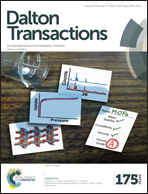A novel samarium(ii) complex bearing a dianionic bis(phenolate) cyclam ligand: synthesis, structure and electron-transfer reactions†
Abstract
The reaction of the hexadentate dianionic 1,4,8,11-tetraazacyclotetradecane-based bis(phenolate) ligand, (tBu2ArO)2Me2-cyclam2−, with [SmI2(thf)2] in thf resulted in the formation of the divalent samarium complex [Sm(κ6-{(tBu2ArO)2Me2-cyclam})] (1). X-ray diffraction studies revealed that after recrystallization from n-hexane/thf complex 1 has a monomeric structure and does not contain thf molecules coordinated to the Sm(II) center. However, UV-vis and 1H NMR spectroscopy of 1 evidenced the formation of thf-solvated complexes in neat thf. Reductive studies show that complex 1 can act as a single electron-transfer reagent and form well-defined Sm(III) species. The reaction of 1 with several substrates, namely, TlBPh4, pyridine N-oxide, OPPh3, SPPh3 and bipyridines, are reported. Spectroscopy studies, including NMR, and single crystal X-ray diffraction data are in agreement with the formation of cationic Sm(III) species, monochalcogenide bridged Sm(III) complexes and Sm(III) complexes with bipyridine radical ligand, respectively.


 Please wait while we load your content...
Please wait while we load your content...